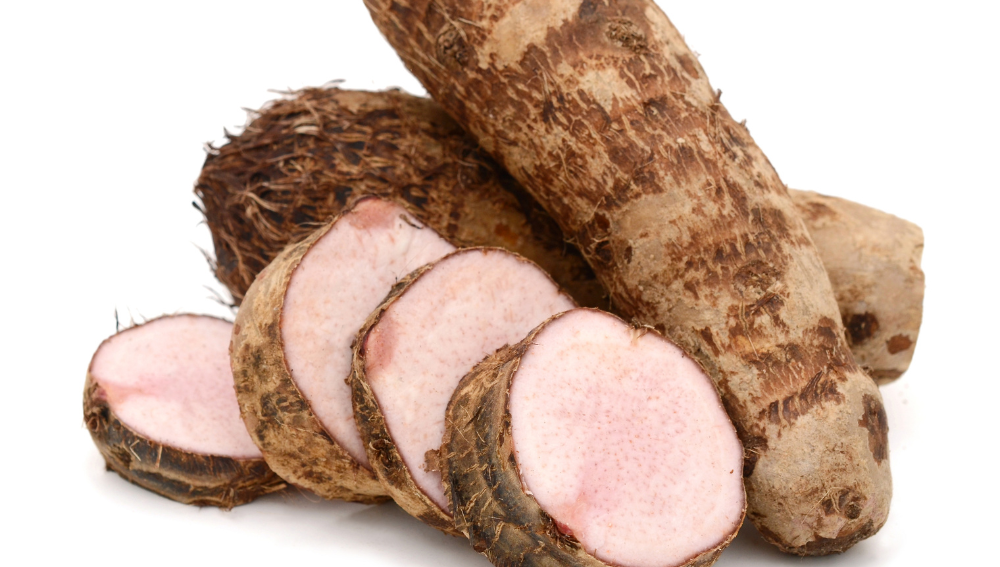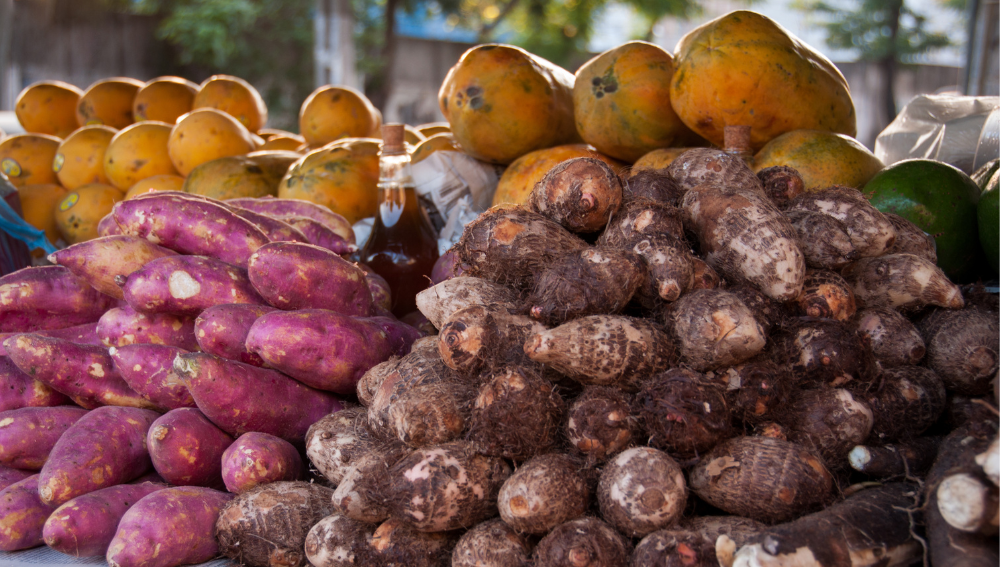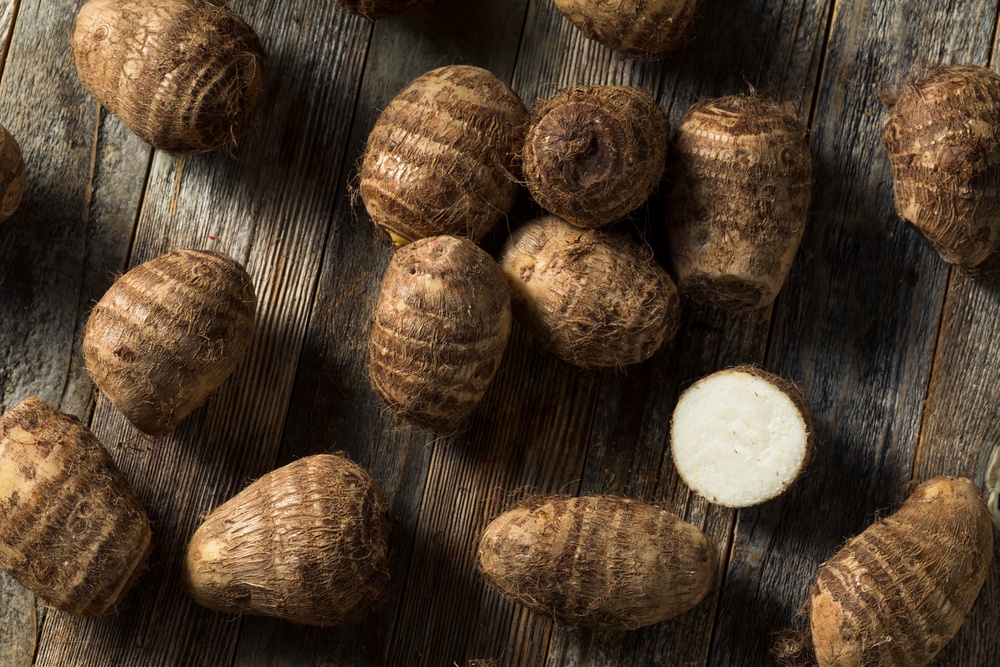Taro root, a staple ingredient in many global cuisines, is known for its versatility and nutritional benefits. However, if you’re unable to find taro root or prefer an alternative, there are a variety of substitutes that can be used in its place.
The key to finding the best taro root substitute is understanding the unique flavor profile and texture of taro, as well as the specific needs of the dish you’re preparing.
Some dishes call for the mildly sweet and starchy flavor of taro root, while others may require a subtler taste or different texture.
The right substitute not only depends on the specific recipe but also on your personal taste and dietary preferences.
Rest assured, there are plenty of viable taro root alternatives that can easily be found in grocery stores or online markets.
Key Takeaways
- Several suitable substitutes can replicate the taste and texture of taro root.
- Choose the best taro root alternative according to the specific recipe and personal preferences.
- Taro root substitutes are easily available in grocery stores or online markets.
Understanding Taro Root

Taro root is a popular starchy root vegetable that is commonly used in many cuisines worldwide. It is derived from the taro plant, which is a tropical plant native to Southeast Asia.
The vegetable has a thick, rough skin that needs to be removed before it can be cooked. Once the skin is removed, the root is revealed, having a creamy and slightly sweet flavor when cooked.
Taro root is rich in vitamins, minerals, and dietary fiber, making it a highly nutritious vegetable. It has ample amounts of vitamin C, B vitamins, and essential minerals such as potassium, magnesium, and calcium.
The high fiber content of taro root helps in digestion and prevents constipation, making it a healthy choice for people with digestive issues.
One of the most common ways to consume taro is by cooking it until it becomes soft and tender. Cooked taro root has a unique, starchy texture that is somewhat similar to a potato, and it can be enjoyed boiled, roasted, or fried.
It can also be mashed or made into a paste to make various dishes like taro chips, taro cakes, and taro pudding.
When choosing taro root, it’s essential to select high-quality vegetables that are firm and fresh, without any visible blemishes or damage.
Storing taro root is quite straightforward – just keep it in a cool and dry place, away from direct sunlight or heat sources. It can be stored for several weeks in the right conditions.
Overall, taro root is a versatile and nutritious vegetable that can be a delicious addition to any diet. With its unique flavor and texture, it is a perfect substitute for other starchy root vegetables such as potatoes or sweet potatoes.
Health Benefits of Taro
Taro root is a nutritious and versatile root vegetable that offers various health benefits. It is packed with essential nutrients, such as fiber, vitamin C, potassium, calcium, iron, magnesium, and zinc.
These nutrients contribute to the overall well-being of individuals who consume taro on a regular basis.
Taro’s fiber content is especially known for its benefits on digestion and weight loss. Consuming a diet rich in fiber can help promote regular bowel movements, prevent constipation, and aid in maintaining a healthy gut.
Furthermore, fiber can help with satiety, thereby assisting in weight loss efforts by preventing overeating and helping to control cravings.
In addition to its high fiber content, taro is an excellent source of vitamin C, which is crucial for a strong immune system and skin health.
Vitamin C acts as an antioxidant, combating free radicals that may lead to premature aging and the development of certain diseases such as cancer.
This versatile vegetable also contains a substantial amount of potassium, which plays a vital role in supporting heart health by regulating blood pressure, maintaining fluid balance, and promoting the proper functioning of muscles and nerves.
Calcium, iron, and magnesium can be found in taro as well, benefiting the body in various ways. Calcium strengthens bones and teeth, while iron supports the transport of oxygen throughout the body.
Magnesium is key to the metabolism of nutrients and assists in muscle and nerve function.
Moreover, taro provides a source of zinc, which is essential for a healthy immune system and wound healing.
Though taro offers many nutritional advantages, it is important to note that it also contains calcium oxalate, a compound known to contribute to kidney stones in susceptible individuals.
To avoid complications from calcium oxalate, it is advised to always cook taro before consumption.
Lastly, taro can support healthy blood sugar management due to its low glycemic index.
Incorporating taro into a balanced diet can help individuals with diabetes or those looking to maintain steady blood sugar levels, as it prevents rapid spikes and dips in glucose levels.
In summary, taro root is a nutrient-rich food that offers numerous health benefits, making it an excellent substitute in various recipes and dishes.
Culinary Uses of Taro

Taro, a versatile root vegetable, is widely used in cuisines across various regions, including Asia and Hawaii.
It can be cooked in numerous ways, from boiling and baking to frying and roasting. Its leaves are also edible and often incorporated into dishes.
In Hawaii, taro is a staple ingredient in traditional dishes. It is commonly used to make poi, a thick paste made from mashed taro root.
Boiled taro root is another popular use, often served as a side dish. In addition, taro leaves are used to wrap and cook fish or other protein sources.
Asian cuisine also heavily features taro, and it can be found in various forms such as powders, chips, or even used in bubble tea.
Taro chips, for example, are a popular snack that involves thinly slicing the root and frying it until crispy. Other applications of taro include:
- Curries: Taro can be added to curries, providing a unique flavor and texture to the dish.
- Roasting: Roasted taro is a delicious and easy-to-prepare side dish or snack.
- Soups: Taro can be incorporated into soups, adding a hearty and starchy element.
- Buns: Taro buns, made from taro paste-filled bread, are a popular item in many Asian bakeries.
- Tea: Taro tea, made from taro powder, is a popular alternative to traditional bubble tea.
- Sauces: Taro can be incorporated into sauces, adding a creamy, rich texture.
When cooking with taro, it is essential to keep in mind its toxic properties when raw. It must always be cooked thoroughly to eliminate the risk of potential health issues.
Whether boiling, baking, roasting, or grilling, taro is a versatile ingredient that offers many culinary possibilities across cuisines.
Handling and Preparing Taro
Taro root, although a nutritious and versatile ingredient, requires careful handling and preparation due to its toxic nature when raw.
Taro contains calcium oxalate crystals, which can cause irritation and itchiness when it comes into contact with skin. To avoid discomfort during the preparation process, it is advisable to wear gloves when handling taro.
Before cutting into the taro root, one should ensure they are using a sharp knife. A dull knife can make the process of peeling and slicing the taro more difficult and potentially dangerous.
With gloves on, first wash the taro to remove any dirt or debris from the skin.
Then, use the knife to cut off both ends of the taro, and proceed to peel it with either a peeler or the knife. Be cautious during this step, as taro may be slippery.
Chopped or grated taro may be used in a variety of recipes, such as soups, stews, and desserts. The pieces should be of uniform size for even cooking.
Keep in mind that raw taro contains small amounts of cyanide compounds, which pose a health risk when consumed. However, these compounds break down during the cooking process, rendering the taro safe to eat.
To eliminate the harmful compounds and fully reap the benefits of taro, it is essential to cook it properly. Boiling, baking, or frying taro for at least 45 minutes will neutralize the cyanide present.
Once cooked, taro can be mashed, pureed, or incorporated into various recipes as a healthy substitute for potatoes or other starchy vegetables.
Remember, it is crucial to follow these preparation steps to ensure safe consumption and avoid adverse reactions while enjoying the nutritious and versatile taro root.
Best Taro Root Substitutes

Taro root is a staple in many cuisines, but it might not always be readily available at your local grocery store.
If you cannot find taro root, there are several substitutes that can mimic its taste and texture, making them ideal options for your culinary endeavors.
Here are some of the best taro root substitutes that you can use in your cooking.
Potatoes are the most common and readily available alternative to taro root. Both have a similar starchy texture, making them suitable for dishes like taro chips or mashed taro.
While russet potatoes might be an obvious choice, consider using Yukon Gold for a creamier texture and buttery taste.
Sweet potatoes can also be used as a taro root substitute, especially when you want to add a touch of sweetness to the dish.
Japanese sweet potatoes, known for their purple skin and creamy white flesh, are particularly close to taro in terms of flavor and consistency.
They can be used in both sweet and savory applications, such as in stews, soups, or even in taro cake recipes.
Yams have a texture that is similar to taro root, although they are sweeter and have a darker flesh. This makes them a suitable alternative for taro in certain recipes where the sweetness won’t overpower the dish.
The distinct flavor of yams may add a noticeable depth to your dish, and they are best used in dishes which can accommodate those variations.
Yucca root and cassava have a similar appearance and starchy texture to taro root, making them suitable substitutes for various preparations.
They can be boiled, fried, or baked in the same way as taro root. However, cassava must be cooked thoroughly to prevent releasing harmful cyanide compounds.
Yucca root and cassava are commonly used in Latin American and African cuisines and impart a unique flavor that complements a variety of ingredients.
Parsnips and carrots are root vegetables with a slightly sweet taste that can replace taro root when used in soups, stews, and gratins.
Their crisp texture softens when cooked, providing a similar mouthfeel to taro root. However, the two vegetables impart a stronger and earthier flavor, which may not be suitable for all recipes.
Other lesser known alternatives to taro root include cocoyam, eddo, malanga, and dasheen.
These exotic root vegetables are often available at select stores catering to specific ethnic cuisines, making them an option for those looking to experiment with diverse flavors and textures.
In conclusion, finding the appropriate substitute for taro root will depend on the specific dish and desired outcome.
It is important to consider the taste and texture that each alternative can provide in order to achieve a culinary result that closely resembles the original taro root recipe.
Availability and Purchase of Taro

Taro root is primarily known as an Asian vegetable, commonly used in various dishes and cuisines. Due to its popularity, it’s generally available in Asian grocery stores, where customers can find fresh taro all year round.
However, the availability of taro in mainstream grocery stores may vary depending on the location.
In non-Asian countries, customers may find it harder to locate taro roots, especially during the off-season.
Therefore, it is important to check the produce section of local grocery stores or explore nearby Asian markets when looking for this unique root vegetable.
The peak season for taro is from autumn to early winter. During this time, the quality and flavor of fresh taro roots are at their best, and they may even be found in some large, well-stocked supermarkets.
Outside of this season, taro may still be available, but it could be frozen or canned, which may slightly change the texture when used as a cooking ingredient.
When purchasing taro, it is essential to look for firm roots with even-colored, thick skins and minimal blemishes. They should have a fresh, earthy smell and feel heavy for their size.
As a perishable product, it should be stored in a cool, dark, and dry place for best quality and shelf life.
In summary, while taro root can be found in most Asian groceries throughout the year, availability and quality may differ during off-season months in non-Asian locations.
By keeping an eye out for the fresh, high-quality taro roots, customers will be able to enjoy the unique flavor and versatility of this remarkable vegetable.
Frequently Asked Questions
Are yucca and taro root interchangeable?
Yucca and taro root are not entirely interchangeable. While both are starchy root vegetables, they have different textures and flavors.
Yucca is firmer and has a milder taste than taro root, which has a creamier texture and an earthy-nutty flavor.
They can still be used as substitutes for each other in some recipes, but the final dishes may have distinct characteristics.
What is the best way to store taro root?
To keep taro root fresh for longer, store it in a cool, dark place like a pantry or cupboard. Avoid refrigerating taro root, as this can cause it to develop a slimy texture and spoil more quickly.
If you have already peeled taro root, wrap it in a damp paper towel and store it in an airtight container in the refrigerator.
Can you use malanga as a substitute for taro root?
Yes, malanga can be used as a substitute for taro root in many recipes. Malanga is another starchy root vegetable with a texture and taste similar to taro root.
It can be used in both savory and sweet dishes, and it holds up well when cooked in soups, stews, and other preparations.
How does eddo root compare to taro root?
Eddo root, also known as dasheen, is similar to taro root in its taste and texture. However, it tends to be smaller and more fibrous than taro, which can affect the final dish’s consistency.
If using eddo root as a substitute for taro root, peeling and grating it before cooking can help minimize the fibrous texture.
What are other starchy alternatives to taro root?
Apart from yucca, malanga, and eddo root, some other starchy alternatives to taro root include potato, sweet potato, turnip, and rutabaga.
These vegetables can be used in similar recipes, but each has its own unique flavor profile and may alter the taste of the final dish.
Is taro root related to sweet potatoes or malanga?
Though taro root, sweet potatoes, and malanga are all starchy root vegetables, they belong to different plant families.
Taro root is part of the Araceae family, while sweet potatoes are Convolvulaceae, and malanga belongs to the Araceae family as well.
Despite their biological differences, these root vegetables share some similarities in culinary uses and can be substituted for each other in certain dishes.







